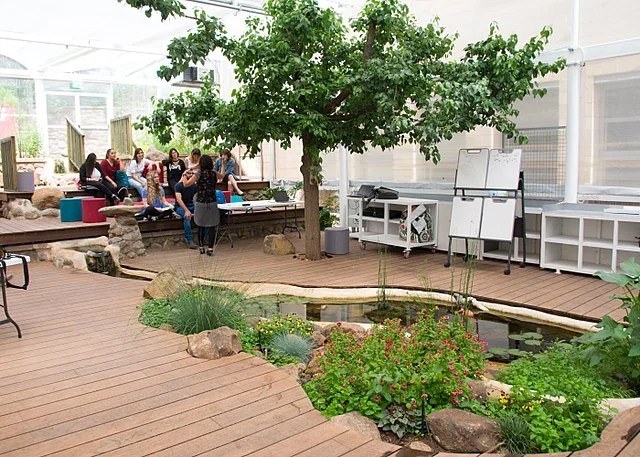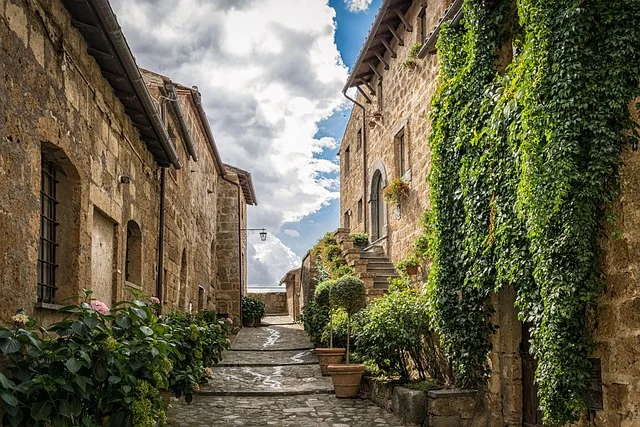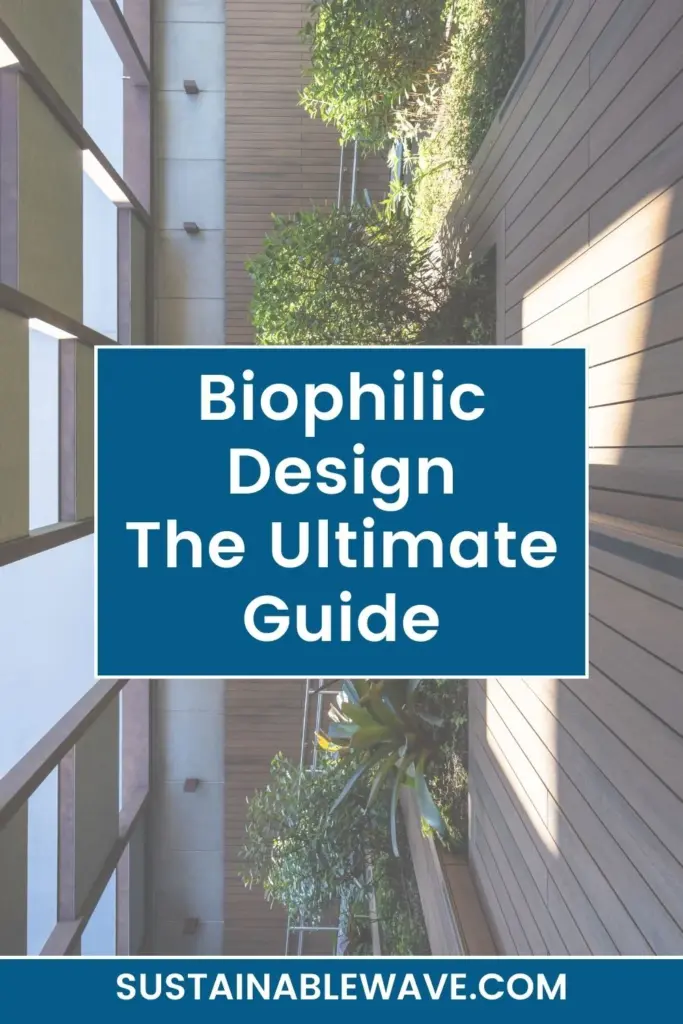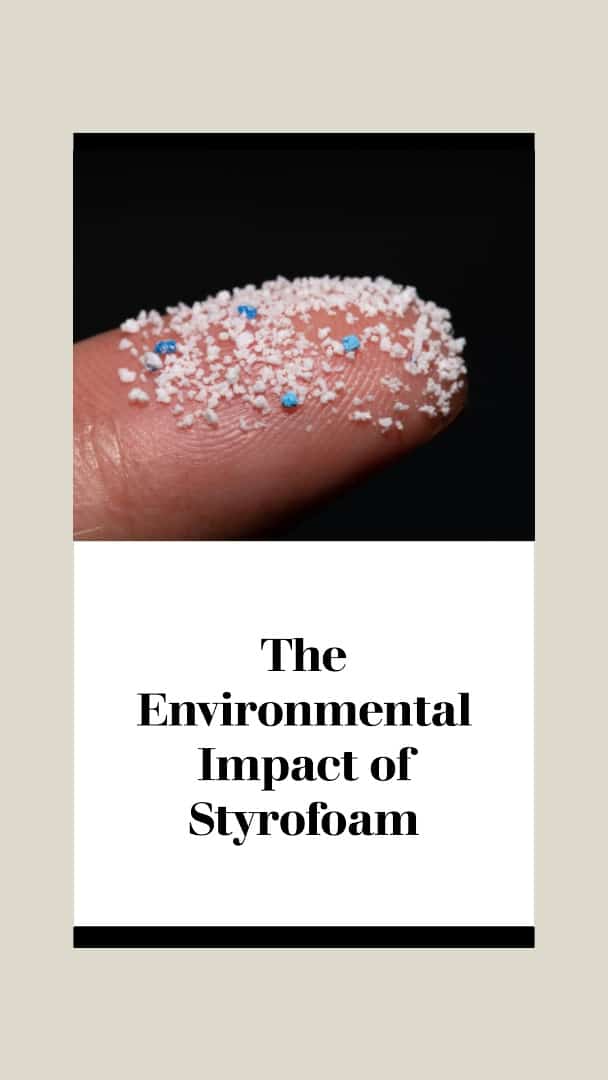The fusion of nature and architecture isn’t just a dreamy concept seen in movies or fairy tales. Instead, it’s the core principle behind the revolutionary Biophilic Design.
The biophilic design philosophy aims to incorporate natural elements within built spaces, promoting well-being, sustainability, and a heightened sense of belonging.
From skyscrapers in bustling urban environments to serene residential settings, Biophilic Design is shaping the way we perceive and interact with our surroundings. Let’s delve into its intricacies.
What Is the Concept of Biophilic Design?

The term ‘Biophilic Design’ derives from the word ‘biophilia,’ which means “love of life or living systems.”
At its essence, Biophilic design is about nurturing the inherent human attraction to nature and natural processes.
Imagine walking into an office space with ample sunlight, green walls, and the soothing sound of flowing water. That’s Biophilic Design in action. It’s a mindful approach to acknowledge our innate need to connect with nature, even in the most urbanized settings.
Origins and Evolution
Though the term might sound contemporary, the practice’s roots trace back to ancient civilizations. From the Hanging Gardens of Babylon to the courtyards in traditional Chinese homes, history showcases multiple instances where nature has seamlessly blended with architecture.
In recent decades, with the rise in environmental consciousness and well-being, Biophilic Design has garnered much-deserved attention.
Why It’s More Than Just Indoor Plants
While incorporating greenery is a significant aspect, Biophilic Design goes beyond that. It encompasses:
- Natural Light: Maximizing daylight and ensuring it penetrates spaces.
- Material Choices: Utilizing materials that evoke nature, like wood and stone.
- Natural Patterns: Incorporating designs that mimic nature’s randomness.
- Sensory Variability: Introducing elements that engage all our senses, from hearing the chirping of birds to feeling the texture of natural surfaces.
What Are the 5 Senses of Biophilic Design?
Biophilic Design aims to rejuvenate our connection with nature, and a holistic approach to achieving this involves engaging all five of our senses, sight, touch, sound, smell, and taste.
1. Sight: This is the most evident aspect, where natural light, vibrant plant colors, and nature-inspired patterns dominate the space, fostering a visually stimulating environment.
2. Touch: The tactile sensation is catered to by using natural materials like wood, stone, and textiles that evoke nature. Imagine walking barefoot on a stone pathway or feeling the rough texture of a wooden surface; it’s about material authenticity.
3. Sound: Incorporating nature’s symphonies, from the gentle gurgling of flowing water to the subtle rustling of leaves or birds chirping, can have a calming effect on inhabitants.
4. Smell: Using indoor plants and natural ventilation methods introduces the refreshing aromas of the earth, flora, and fauna, providing a rejuvenating experience.
5. Taste: Though less direct, having edible plants, herb gardens, or even urban farms within Biophilic spaces can offer fresh, organic produce, directly connecting occupants to the taste of nature.
Together, these sensory engagements craft an immersive experience, making Biophilic Design truly transformative.
Top Benefits of Adopting Biophilic Design
Embracing this design philosophy offers multifaceted benefits:
Enhanced Well-being and Productivity
Various studies suggest that exposure to natural elements can reduce stress and increase productivity. For instance, employees in workspaces with natural elements reported a 15% higher level of well-being and 6% higher productivity than those in standard office settings (source).
Sustainability and Energy Efficiency
By maximizing natural light and integrating passive cooling techniques like green roofs, buildings can substantially reduce their energy consumption.
Boosted Real Estate Value
Biophilically designed spaces often fetch higher rents and have better occupancy rates due to their inherent appeal.
Promotes Conservation and Biodiversity
Such designs often incorporate local flora and fauna, leading to increased biodiversity. It’s a win-win, as it educates inhabitants about local ecosystems and promotes conservation efforts.
Fosters Community and Social Ties
Shared green spaces can act as communal hubs, encouraging interactions and fostering a sense of community.
Implementing Biophilic Design: Practical Steps
Biophilic Design isn’t just a philosophy; it’s a way of life, deeply ingrained in our human nature. Implementing it requires a thoughtful approach that transcends mere aesthetics.
Whether you’re retrofitting an existing space or building anew, here’s a more in-depth look at some practical steps to incorporate this groundbreaking design approach:
Start Small
Embarking on the journey of Biophilic Design doesn’t necessitate a complete overhaul immediately. Begin with subtle changes. Introducing indoor plants can be a great start, considering their varied benefits from purifying the air to boosting mood.
Gradually, as you grow comfortable, consider maximizing natural light through skylights, larger windows, or using reflective surfaces. The idea is to gradually create a symbiotic relationship between the indoors and the outdoors, ensuring neither overpowers the other.
Engage Experts
As the adage goes, “A little knowledge is a dangerous thing.” Delving into Biophilic Design without proper guidance can lead to misplaced efforts. Hiring architects or designers who specialize in this philosophy can provide invaluable insights.
They can help in crafting spaces that resonate with the ethos of Biophilic Design, ensuring the spaces are not just beautiful but functionally sound and genuinely beneficial.
Think Locally
A key facet of Biophilic Design is authenticity. Using local materials and plants ensures the design aligns with the surrounding ecosystem. Not only does it reduce transportation and associated environmental costs, but it also contributes to preserving local biodiversity.
Additionally, local materials, due to their inherent properties, often perform better in local climatic conditions, leading to structures that are more durable and sustainable.

What Is the Difference Between Biophilia and Biophilic Design?
In the realm of architecture and design, the terms “Biophilia” and “Biophilic Design” are often used interchangeably. However, they represent distinct concepts, each with its unique significance. Though interconnected, understanding their differences is essential for anyone keen on fostering a deep connection with nature through built environments.
The main difference between Biophilia and Biophilic Design is that while Biophilia is our innate emotional connection to nature, Biophilic Design is the tangible method by which we manifest this connection in our surroundings.
Biophilia refers to the inherent human inclination to affiliate with nature and natural processes. It’s a deep-seated love and affinity we humans have toward the natural world.
On the other hand, Biophilic Design is the application of this concept in architectural and design practices. It’s the intentional process of integrating elements of nature and natural forms into human-made spaces, ensuring an enhanced connection to the natural environment.
What Is the Difference Between Biophilic and Sustainable Design?
Navigating the world of environmentally-conscious design can sometimes be a maze of terminologies. Two terms that often emerge in discussions are “Biophilic Design” and “Sustainable Design.” Both advocate for a more harmonious relationship between human-made environments and the natural world, yet they represent distinct philosophies.
The main difference between Biophilic and Sustainable Design is their primary focus. While Biophilic Design prioritizes human-nature interaction, Sustainable Design is rooted in conservation and efficient resource use. Both, however, contribute significantly to a more holistic approach to modern design.
Biophilic Design centers on integrating nature into built environments to foster a direct human-nature connection, aiming to improve well-being and evoke a sense of place. It’s about harnessing the emotional, psychological, and physical benefits of being close to nature.
In contrast, Sustainable Design emphasizes the efficient use of resources, reduced environmental impact, and long-term viability. Its primary goal is to minimize negative environmental effects through skillful, sensitive design, ensuring the structure’s longevity with minimal resource depletion.
Global Examples of Biophilic Design
From commercial establishments to residential spaces, here are some examples that have embraced this philosophy with open arms:
A series of biomes housing diverse plant species from across the globe, it’s a masterclass in sustainable architecture.
An urban office building that doubles up as an urban farm, producing rice, tomatoes, and broccoli right in the heart of Tokyo.
Khoo Teck Puat Hospital, Singapore
It integrates healing gardens and water bodies within its premises, significantly enhancing patient recovery rates.
FAQs
What’s the core principle of Biophilic Design?
It seeks to integrate natural elements into built environments, catering to humans’ inherent attraction to nature.
Does it only involve adding plants to spaces?
No, it’s a holistic approach that includes maximizing natural light, using nature-inspired materials, and patterns, and engaging all our senses.
Is it a contemporary concept?
While the term is modern, the practice can be traced back to ancient civilizations, evident in historical architectural marvels.
Does Biophilic Design contribute to sustainability?
Absolutely! By incorporating strategies like passive cooling and maximizing daylight, such designs often lead to energy-efficient spaces.
Can I implement Biophilic Design in my existing home or office?
Yes, you can start small, like introducing indoor plants, and gradually make more significant changes with expert advice.
Conclusion

Biophilic Design isn’t just a trend; it’s a testament to the timeless bond between humans and nature.
As we progress in our architectural endeavors, recognizing and fostering this connection will be paramount. Whether it’s a humble home or a sprawling commercial space, the touch of nature can transform it into a sanctuary of well-being and creativity.
Dive into the realm of Biophilic Design, and embrace a future where nature and architecture walk hand in hand.
I’m Thomas, the owner of SustainableWave. Passionately promoting a sustainable planet. With experience in various eco-roles, I’ll share green tips, sustainability hacks, and personal eco-journeys on my blog.






